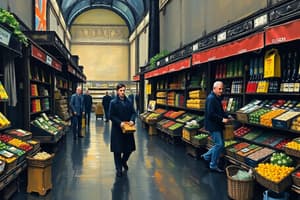Podcast
Questions and Answers
Which of the following best describes a key function of retailers within a supply chain?
Which of the following best describes a key function of retailers within a supply chain?
- Setting international trade policies.
- Acting as intermediaries between producers and consumers. (correct)
- Producing raw materials for manufacturing.
- Financing large-scale infrastructure projects.
A store that specializes in a deep selection and expertise within a specific product category is best described as a:
A store that specializes in a deep selection and expertise within a specific product category is best described as a:
- Specialty store. (correct)
- Department store.
- Supermarket.
- Discount store.
Which of the following is NOT typically considered a primary function of merchandising?
Which of the following is NOT typically considered a primary function of merchandising?
- Presenting products to the right market at the appropriate time.
- Implementing effective display and sales techniques.
- Executing organized advertising strategies.
- Overseeing the company's financial audits. (correct)
A retailer is determining the ideal breadth and depth of their product offerings. This process is best described as:
A retailer is determining the ideal breadth and depth of their product offerings. This process is best described as:
A clothing retailer decides to offer a 'buy one, get one 50% off' promotion. This initiative falls under which element of the retail strategy?
A clothing retailer decides to offer a 'buy one, get one 50% off' promotion. This initiative falls under which element of the retail strategy?
What is the primary goal of omnichannel retailing?
What is the primary goal of omnichannel retailing?
A retailer analyzes past purchase data to send personalized product recommendations to customers. This practice exemplifies which trend in retailing?
A retailer analyzes past purchase data to send personalized product recommendations to customers. This practice exemplifies which trend in retailing?
Which aspect of retail operations is MOST directly concerned with optimizing customer traffic flow and product placement within a store?
Which aspect of retail operations is MOST directly concerned with optimizing customer traffic flow and product placement within a store?
What is the primary purpose of visual merchandising?
What is the primary purpose of visual merchandising?
A retail employee effectively addresses a customer's complaint about a defective product by offering a full refund or exchange. This demonstrates the importance of:
A retail employee effectively addresses a customer's complaint about a defective product by offering a full refund or exchange. This demonstrates the importance of:
Which retail technology is MOST directly associated with tracking inventory levels and automating the reordering process?
Which retail technology is MOST directly associated with tracking inventory levels and automating the reordering process?
A grocery store offers a loyalty program with exclusive discounts to repeat customers. This is an example of what type of retail marketing?
A grocery store offers a loyalty program with exclusive discounts to repeat customers. This is an example of what type of retail marketing?
When selecting a retail location, analyzing the ease with which customers can access the store through parking and public transportation relates to:
When selecting a retail location, analyzing the ease with which customers can access the store through parking and public transportation relates to:
A retailer ensures that all products meet established safety standards before offering them for sale. This demonstrates attention to:
A retailer ensures that all products meet established safety standards before offering them for sale. This demonstrates attention to:
A company adopts a policy of sourcing materials only from suppliers who adhere to fair labor practices. This decision reflects which of the following?
A company adopts a policy of sourcing materials only from suppliers who adhere to fair labor practices. This decision reflects which of the following?
Flashcards
Retail Services
Retail Services
Selling goods/services directly to consumers for personal use.
Retail Role in Supply Chain
Retail Role in Supply Chain
Acting as intermediaries connecting producers/wholesalers to consumers.
Department Stores
Department Stores
Stores with wide variety in separate departments (clothing, home goods).
Discount Stores
Discount Stores
Signup and view all the flashcards
Specialty Stores
Specialty Stores
Signup and view all the flashcards
Assortment planning
Assortment planning
Signup and view all the flashcards
Inventory management
Inventory management
Signup and view all the flashcards
Target market identification
Target market identification
Signup and view all the flashcards
Omnichannel Retailing
Omnichannel Retailing
Signup and view all the flashcards
Personalization (in Retailing)
Personalization (in Retailing)
Signup and view all the flashcards
Store layout and design
Store layout and design
Signup and view all the flashcards
Visual merchandising
Visual merchandising
Signup and view all the flashcards
Greeting and assistance
Greeting and assistance
Signup and view all the flashcards
Point-of-sale (POS) systems
Point-of-sale (POS) systems
Signup and view all the flashcards
Site selection
Site selection
Signup and view all the flashcards
Study Notes
- Retail services encompass all activities involved in selling goods or services directly to final consumers for personal, non-business use
- The role of retailing in the supply chain involves retailers acting as intermediaries between producers/wholesalers and consumers
- Retailers perform functions like assortment planning, inventory management, and customer service
Types of Retailers
- Department stores carry a wide variety of merchandise, often including clothing, home goods, and appliances, organized into separate departments
- Discount stores offer a wide assortment of merchandise at lower prices, often focusing on high-volume sales
- Specialty stores concentrate on a specific type of merchandise, offering a deep selection and expertise in that area
- Supermarkets primarily sell food and household items, typically operating on a self-service basis
- Convenience stores are small stores that offer a limited selection of everyday items at easily accessible locations
- Online retailers sell products directly to consumers through the internet
- Off-price retailers sell brand-name merchandise at discounted prices, often due to overstocks, closeouts, or irregulars
- Warehouse clubs require membership and offer a variety of products in bulk at low prices
Key Retail Functions
- Merchandising is the planning and promotion of sales by presenting a product to the right market at the proper time and by carrying out organized, skillful advertising, display, and sales methods
- Assortment planning involves determining the variety and depth of products to offer customers
- Inventory management includes ordering, receiving, storing, and tracking merchandise to ensure products are available when customers want them
- Pricing strategies involve setting prices that are competitive, profitable, and attractive to customers
- Promotion and advertising communicate product information and attract customers to the store
- Customer service includes assisting customers with their purchases, handling complaints, and providing support
The Retail Strategy
- Target market identification involves determining the specific group of customers a retailer aims to serve
- Product and service assortment includes deciding on the breadth and depth of merchandise offered
- Pricing strategy determines how products will be priced to attract customers and generate profit
- Promotional strategy involves deciding how to communicate with customers and promote the store and its products
- Store design and visual merchandising creates an appealing and functional shopping environment
- Customer service strategy defines the level and type of service provided to customers
- Location strategy involves choosing accessible and high-traffic locations
Trends in Retailing
- Growth of online retailing is rapidly increasing due to convenience, wider selection, and competitive prices
- Omnichannel retailing provides a seamless shopping experience across multiple channels (online, in-store, mobile)
- Personalization tailors the shopping experience to individual customer preferences and needs
- Mobile commerce uses mobile devices (smartphones, tablets) for shopping and payments
- Increased focus on customer experience emphasizes creating memorable and positive interactions
- Use of data analytics gathers data to understand customer behavior and improve decision-making
- Sustainability focuses on environmentally friendly practices and products
Retail Operations
- Store layout and design aims to optimize traffic flow, product placement, and overall shopping experience
- Visual merchandising presents products in an appealing and attention-grabbing manner
- Staffing and training ensures employees are knowledgeable, helpful, and able to provide excellent customer service
- Inventory control minimizes stockouts and overstocks through efficient tracking and management
- Loss prevention protects against theft, fraud, and other sources of loss
- Security measures ensure a safe and secure shopping environment for customers and employees
Customer Service in Retail
- Greeting and assistance involves welcoming customers and helping them find what they need
- Product knowledge requires staff to be well-informed about the products they sell
- Handling complaints and returns involves resolving customer issues fairly and efficiently
- Building relationships establishes rapport with customers and encourages repeat business
- Providing personalized service tailors the shopping experience to individual customer preferences
- Customer feedback mechanisms gathers customer opinions and suggestions for improvement
Retail Technology
- Point-of-sale (POS) systems process transactions and track sales data
- Inventory management systems track inventory levels and automate reordering
- Customer relationship management (CRM) systems manage customer data and personalize communications
- E-commerce platforms enable online sales and order management
- Mobile payment systems allow customers to pay with their smartphones or other mobile devices
- Data analytics tools analyze sales data and customer behavior to improve decision-making
- RFID (radio-frequency identification) tracks inventory and assets wirelessly
Retail Marketing
- Market research gathers information about customer needs, preferences, and behavior
- Target market selection determines the specific group of customers to focus on
- Branding creates a unique identity and image for the retail store
- Advertising promotes the store and its products through various channels
- Sales promotions incentivize customers to make purchases (discounts, coupons, loyalty programs)
- Public relations manages the store's reputation and relationships with the public
- Social media engages customers and promotes the store and its products
Retail Location
- Trade area analysis identifies the geographic area from which a store draws its customers
- Site selection involves choosing a location that is accessible, visible, and has sufficient traffic
- Accessibility considers ease of access for customers (parking, public transportation)
- Visibility ensures the store is easily seen from the street or other vantage points
- Competition analyzes the presence and impact of competing retailers in the area
- Rent and lease terms determine the cost of occupying the retail space
Legal and Ethical Considerations
- Consumer protection laws protect customers from unfair or deceptive business practices
- Product safety regulations ensure products meet safety standards
- Privacy laws protect customer data and privacy
- Advertising regulations govern the truthfulness and accuracy of advertising claims
- Employment laws regulate the treatment of employees
- Environmental regulations address environmental impacts of retail operations
- Ethical considerations address issues such as fair pricing, responsible sourcing, and community involvement
Studying That Suits You
Use AI to generate personalized quizzes and flashcards to suit your learning preferences.
Description
Retail services involve selling goods/services to consumers for personal use. Retailers link producers/wholesalers to consumers, managing assortment, inventory, and customer service. Different types include department, discount, specialty, supermarkets and online retailers.




